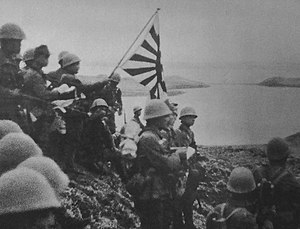Japanese occupation of Kiska
| Japanese occupation of Kiska | |||||||
|---|---|---|---|---|---|---|---|
| Part of the American Theater and the Pacific Theater of World War II | |||||||
 Japanese troops raise the Imperial battle flag on Kiska after landing on 6 June 1942. |
|||||||
|
|||||||
| Belligerents | |||||||
| Commanders and leaders | |||||||
|
Lt. Mulls (Not present during initial landing) |
|
||||||
| Strength | |||||||
| 10-man weather station 1-6 dogs 3 aircraft |
+500 Special Naval Landing Forces (Initial force) 5,183-5,400 civilians and soldiers (Occupation) |
||||||
| Casualties and losses | |||||||
| 2 killed 7 captured 1 escaped (later surrendered) |
No casualties during initial capture, or during occupation/withdraw. | ||||||
The Japanese occupation of Kiska took place between 6 June 1942 and 28 July 1943 during the Aleutian Islands Campaign of the American Theater and the Pacific Theater of World War II. The Japanese occupied Kiska and nearby Attu Island in order to protect the northern flank of the Japanese Empire.
Initially, the only American military presence on Kiska was a twelve-man United States Navy weather station and a dog named Explosion, two of whom were not present during the invasion. The Japanese stormed the station, killing two Americans and capturing seven. After realizing that Chief petty officer William C. House had escaped, a search was launched by the occupying forces. The search ended in vain, with House surrendering some fifty days after the initial seizure of the weather station, having been unable to cope with the freezing conditions & starvation. After 50 days of eating only plants and worms, he weighed just 80 pounds. Beforehand, the prisoners of war had been sent to Japan.
...
Wikipedia
